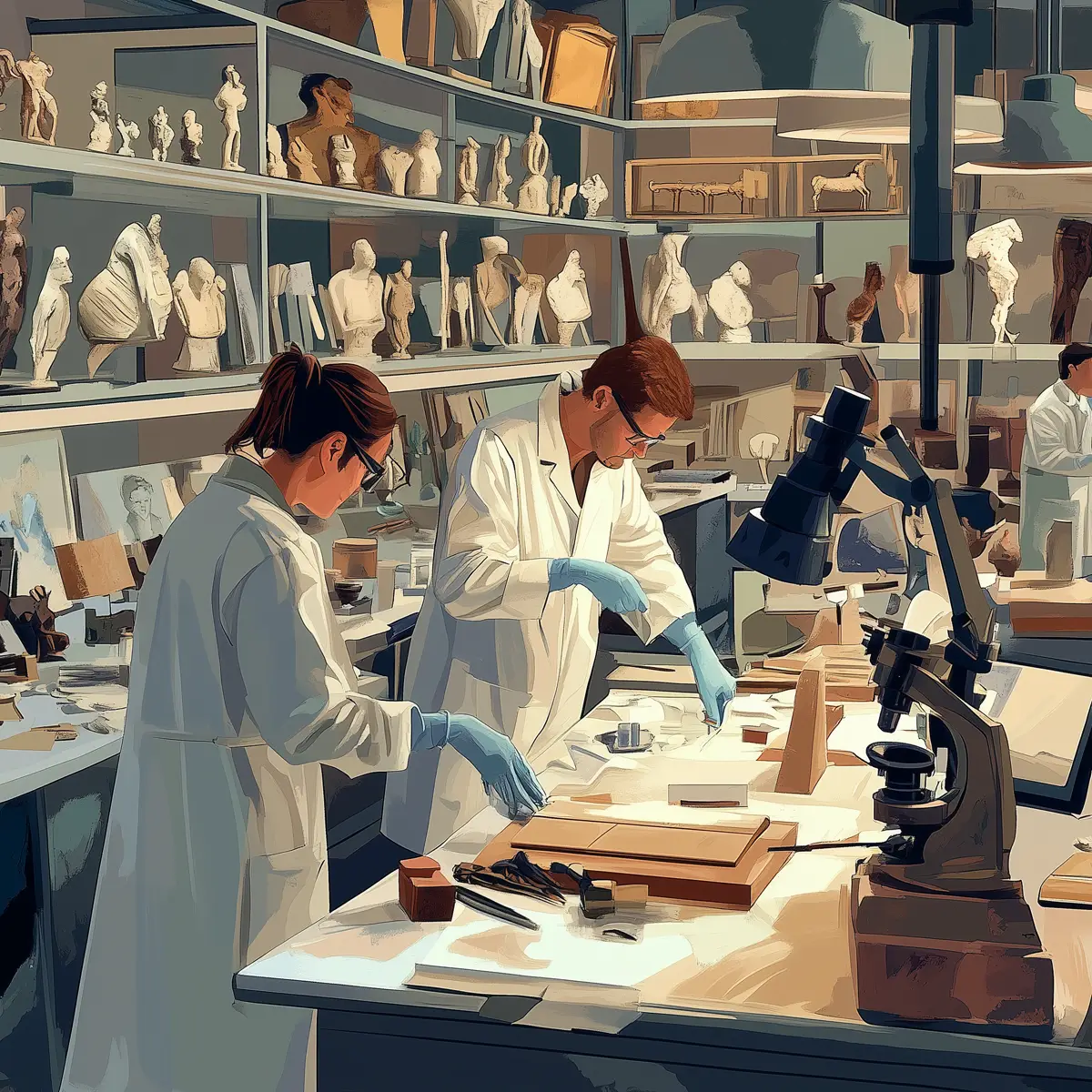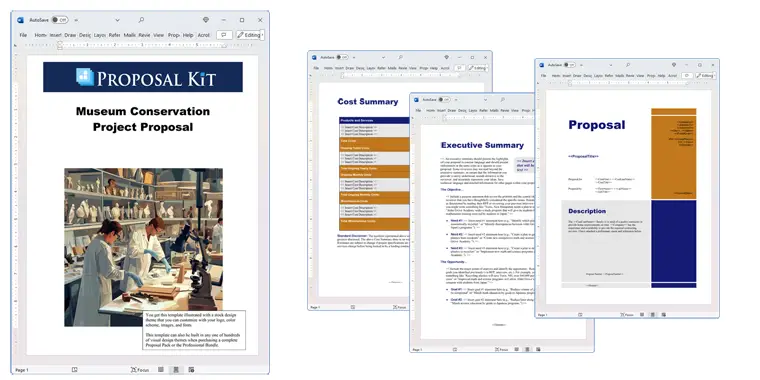How to write your Museum Conservation Project Proposal
We include this 18 page layout with every Proposal Pack. If you want this template to have a different visual design theme than the one illustrated here, purchase any Proposal Pack design and create this template using the purchased design theme. This template is included in every Proposal Pack. If you get a Proposal Pack or the Professional, you can also make any variation of this template with different chapters to suit your needs.
We typically include more chapters in the templates than most people will need to give everyone more variety in the chapters they may need. You can trim down a long template by removing pages you do not need or combining multiple chapter topics into one page.
 DOWNLOADABLE, ONE-TIME COST, NO SUBSCRIPTION FEES
DOWNLOADABLE, ONE-TIME COST, NO SUBSCRIPTION FEES If you need only this template pre-assembled on DVD media order from our Amazon shop.
If you need only this template pre-assembled on DVD media order from our Amazon shop.
You can also create countless variations of this document to suit your needs using the included library of 2200+ chapters if ordering a Proposal Pack or Professional.
 What Our Clients Say
What Our Clients SaySince 2009 I have been using the proposals for my consulting business. Now more then ever do I realize the value of having formatted documents that guide you through the proposal process. Having the ability to have the documents in Microsoft office format saves me even more time and effort since I already am familiar with the office suite. Many of the other proposal products on the market force you to use their proprietary word processor and spreadsheet tools which is more time consuming."
Vice-President Marketing at Allgress
Related Article
Related Video
Related Templates
- Research Assistant Proposal
- Sponsorship of Non-Profit Proposal
- Preservation of a Native Culture and Language Proposal
- Non-profit Support Proposal
- Grant Funding Request Proposal
What's the best way to write your museum conservation project proposal?
When writing a museum conservation project proposal, the best option is to use the efficiency and comprehensive structure of the Proposal Kit template and software package. Proposal Kit streamlines the proposal writing process with its extensive template library and Wizard software program, which includes a sophisticated line item quoting database system. This system assists in creating detailed cost summaries, quotes, estimates, budgets, and other financial documents vital for your proposal.
Do you need to write a proposal for a museum conservation project or a similar endeavor? If so, Proposal Kit can significantly simplify your task.
What Types of Projects Are Museum Conservation Project Proposals Written For?
Museum conservation projects can vary widely; some common types often require well-structured proposals. These examples highlight the broad scope of situations that proposals are written for:
- Artifact restoration
- Preventive conservation measures
- Exhibition design and installation
- Climate control solutions
- Light and UV radiation management
- Pest control and mitigation
- Digital archiving and cataloging
- Structural repairs for museum buildings
- Interactive display installations
- Conservation science research projects
- Public educational program development
- Acquisition of new collections
- Conservation equipment upgrades
- Staff training in conservation techniques
- Historical building conservation
- Emergency preparedness planning
- Sustainability initiatives
- Conservation outreach programs
- Grant writing for conservation funding
- Collaboration with international conservation experts
Chapters this template is built with
Creating a museum conservation project proposal is more complex than a one-size-fits-all template can cover. Proposal Kit's software allows users to customize proposal templates to fit the unique needs of any project using pre-made layouts as a starting point. Even though the Proposal Kit includes thousands of chapter templates, here's how a selection of these can specifically aid in writing your museum conservation project proposal:
Cover Letter
Introduce your proposal with a personal touch, summarizing your organization's intent and the significance of the conservation project. Highlight key points such as your team's unique value, a brief overview of the project, and a call to action for the stakeholders to support your initiative.
Introduction
Set the stage by outlining the context of the proposal and detailing the importance and urgency of the conservation efforts. Explain the historical significance of the items or structures to be conserved and provide background information that underscores the necessity of the project.
Estimate
Provide a clear and detailed estimate of the project costs using the Proposal Kit's quoting tools to ensure accuracy and professionalism. Break down expenses into labor, materials, equipment, and additional resources, offering a clear view of the financial requirements.
Needs Assessment
Analyze and specify the conservation needs that the project aims to address, demonstrating understanding and thorough preparation. This section should identify specific issues such as deterioration, environmental hazards, or damage that require intervention, supported by data or visual evidence if available.
Goals and Objectives
Define the project's aims and set measurable targets to evaluate progress and success. Objectives could include stabilizing a historical artifact, improving climate control systems, or training staff in new conservation techniques.
Procedures
Outline the step-by-step process to meet the project's objectives, ensuring clarity and logical flow. Detail each project phase from initial assessment to final evaluation, specifying responsibilities, timelines, and key milestones.
Approach
Detail the methodologies and techniques for conservation, highlighting innovation or adherence to proven practices. Describe why certain methods were chosen and how they align with best practices in the field of conservation.
Preservation
Discuss long-term strategies for preserving items or structures, emphasizing sustainability and effectiveness. This could include ongoing maintenance plans, environmental control measures, or technology integration to monitor artifact conditions.
Research
Incorporate preliminary research findings or case studies supporting the chosen conservation methods. Present any relevant historical data, scientific analyses, or prior project outcomes that reinforce the feasibility and necessity of your approach.
Techniques
Describe specific techniques used in the conservation process, showcasing expertise and specialization. This might involve chemical treatments, digital restoration processes, or traditional methods adapted for modern use.
Conservation
Focus on the practical topics of the conservation work, detailing the materials and resources needed. Include information about sourcing specialized materials, the qualifications of the conservators, and the projected timeline for completing various tasks.
Evaluation
Explain how the project's outcomes will be measured and evaluated against the objectives. Define the metrics for success, such as condition improvements, stakeholder satisfaction, or the educational impact of the project.
Value
Highlight the conservation project's cultural, historical, and financial value to stakeholders and the community. Emphasize how the project will preserve heritage, boost the museum's reputation, attract visitors, and potentially increase funding opportunities.
Recommendations
Provide additional suggestions or related projects to enhance or extend the conservation efforts. These include future conservation plans, partnerships with other institutions, or community engagement initiatives to raise awareness and support.
Capabilities
Showcase your organization's qualifications, experience, and capability to undertake and complete the project. Highlight past successful projects, key team members' expertise, and any relevant certifications or professional affiliations.
Use cases for this template
Breathing New Life into Century-Old Artifacts
The Challenge
Jane at Heritage Revive Co. was given the complex and sizeable task of writing a proposal for the restoration of century-old artifacts. The artifacts, ranging from ancient textiles to fragile manuscripts, required meticulous conservation techniques. Jane felt overwhelmed by the scale of the project and the documentation necessary to convince stakeholders of its value and feasibility.
The Solution
Jane decided to use the Proposal Kit to streamline the proposal writing process. With access to a comprehensive library of templates, she could easily include detailed estimates, outline preservation techniques, and present a clear plan. Using the Proposal Kit software, she created a professional and thorough proposal with a structured approach that left no stone unturned.
The Implementation
Jane tailored specific chapters from the Proposal Kit to fit her project needs. The Cover Letter provided an introduction, while the Needs Assessment identified the artifacts needing restoration. She used the Procedures and Techniques chapters to explain the methodologies employed. The Estimate chapter provided a detailed breakdown of costs, and the Capabilities section highlighted her team's expertise and past successes.
The Outcome
Her comprehensive and well-structured proposal was well-received. Stakeholders were impressed with the clarity and depth of the documentation. Jane secured the necessary funding and support, allowing Heritage Revive Co. to embark on the large-scale restoration project. The century-old artifacts were preserved, ensuring their longevity for future generations.
Integrating Cutting-Edge Digital Archiving Solutions
The Challenge
Mike at Archive Innovate LLC needed to write a proposal for implementing state-of-the-art digital archiving solutions. With a tight deadline and the need to include extensive technical detail, Mike found the task daunting. His company needed to illustrate how their approach would revolutionize the museum's archival processes.
The Solution
Turning to the Proposal Kit, Mike was able to construct a detailed and professional proposal. He used an AI tool to pull relevant data and content from their company website, ensuring the proposal was accurate and aligned with their branding and message. Proposal Kit's templates allowed Mike to create a structured document covering all necessary digital archiving project topics.
The Implementation
Mike customized the digital archiving proposal template. He provided a thorough Introduction and detailed the project's scope using the Approach and Techniques chapters. The Research section supported their proposed methodologies with relevant studies and data. The Estimate chapter laid out the financial topics clearly, and the Value section explained the long-term benefits of their digital solutions.
The Outcome
Mike managed to meet the tight deadline with a proposal that was both comprehensive and persuasive. His detailed and professional proposal won the project, impressing the museum's decision-makers. As a result, Archive Innovate LLC was able to implement its advanced archiving techniques, significantly enhancing the museum's ability to preserve and manage its collections digitally.
Launching a Comprehensive Conservation Training Program
The Challenge
Sarah, a director at EduConserv, was tasked with writing a Request for Proposal (RFP) for a new conservation training program. The program aimed to equip museum staff with advanced conservation skills, ensuring the ongoing preservation of valuable artifacts. Sarah needed to articulate the program's goals, methodologies, and expected outcomes to attract qualified bidders.
The Solution
Sarah relied on the Proposal Kit to create a detailed and precise RFP. The extensive template library gave her all the necessary components to create a professional document. From defining the Goals and Objectives to outlining the Procedures and Approach, the Proposal Kit ensured that Sarah's RFP was comprehensive and aligned with industry standards.
The Implementation
She personalized the training program proposal, starting with a Cover Letter. The introduction sets the context, and the needs assessment identifies the gaps in current staff training. The Goals and Objectives chapter laid out what the program aimed to achieve. Procedures and Approach chapters detailed the methodologies and training techniques. Sarah also incorporated an Evaluation section to explain how the program's success would be measured.
The Outcome
Sarah's well-structured and detailed RFP attracted multiple qualified bidders, each bringing expertise and innovative approaches. After a thorough evaluation, EduConserv selected the best service provider to implement the conservation training program. The initiative enhanced the museum staff's skills and contributed significantly to the preservation of the museum's collections.
Conclusions and Recommendations
Proposal Kit offers an advantage for writing complex proposals efficiently. Whether dealing with artifact restoration, digital archiving, or developing educational programs, Proposal Kit provides the templates, tools, and guidance necessary to create professional, persuasive proposals that win bids and contracts.
Also Known As
This template may also be referred to in different ways or be used in more specialized situations, such as:
- Museum Preservation Proposal
- Artwork Conservation Proposal
- Historical Artifact Project Proposal
- Museum Project Bid Document
- Conservation Treatment Plan
- Museum Restoration Request for Proposal
- Exhibit Conservation Strategy Proposal
- Cultural Heritage Preservation Proposal
- Gallery Improvement Proposal
- Museum Upgrade Proposal Document
Abstract
 In the field of museum conservation, the proposed project involves creating a comprehensive grant proposal to secure funding for important preservation efforts at esteemed institutions. This endeavor is crucial for safeguarding fine arts and cultural artifacts. Applicants are encouraged to submit detailed plans that assess the current condition and conservation needs of their collections, ensuring a sustainable future for these priceless assets.
In the field of museum conservation, the proposed project involves creating a comprehensive grant proposal to secure funding for important preservation efforts at esteemed institutions. This endeavor is crucial for safeguarding fine arts and cultural artifacts. Applicants are encouraged to submit detailed plans that assess the current condition and conservation needs of their collections, ensuring a sustainable future for these priceless assets.
The work plan should encompass all topics from artifact restoration to climate control and digital archiving, demonstrating a thorough understanding of the complex conservation challenges. By integrating methodologies such as pest control, preventive measures, and structural repairs, the proposal aims to successfully complete conservation goals. The Proposal Kit offers valuable support through its extensive template library and automated line-item quoting system, streamlining the preparation of detailed estimates and budgets for this significant initiative. The ultimate objective is to preserve cultural heritage while showcasing the capabilities of institutions to manage and conserve their collections, thereby enhancing the museum's reputation and financial backing.
Museum conservation projects are in preserving the cultural and historical legacy, ensuring that future generations can appreciate and learn from these treasures. The proposed project, which is set within the enclosed field of fine arts, highlights the pressing need for meticulous preservation strategies. This grant proposal seeks to attract applicants who are dedicated to the sustainable management of art and heritage collections.
 By using resources like the Proposal Kit, applicants can create robust and professional proposals tailored to secure the necessary funding. These proposals are important for banks and funding bodies to evaluate the financial feasibility and impact of conservation efforts. The Proposal Kit's user-friendly interface and comprehensive content libraries allow applicants to focus on articulating the unique needs and strategies of their projects, thereby increasing their chances of obtaining financial backing. Ultimately, successful conservation projects not only protect invaluable artifacts but also enhance the institution's reputation, draw more visitors, and open new opportunities for collaboration and knowledge exchange within the global museum community.
By using resources like the Proposal Kit, applicants can create robust and professional proposals tailored to secure the necessary funding. These proposals are important for banks and funding bodies to evaluate the financial feasibility and impact of conservation efforts. The Proposal Kit's user-friendly interface and comprehensive content libraries allow applicants to focus on articulating the unique needs and strategies of their projects, thereby increasing their chances of obtaining financial backing. Ultimately, successful conservation projects not only protect invaluable artifacts but also enhance the institution's reputation, draw more visitors, and open new opportunities for collaboration and knowledge exchange within the global museum community.
The conservation of cultural assets plays a vital role in preserving rich artistic heritage. These initiatives are not just about maintaining the physical integrity of artifacts but also about safeguarding the stories and historical contexts they embody. In developing a grant proposal, applicants must demonstrate how their projects will contribute to the broader cultural landscape.
By employing the sophisticated tools provided by Proposal Kit, applicants can present compelling narratives and detailed financial plans that resonate with funding bodies. This approach not only aids in securing the necessary resources but also ensures transparency and accountability in how funds are used. Successful conservation projects enhance public engagement and education, offering communities a deeper understanding of their cultural history. As museums strive to innovate and expand their reach, well-written proposals become instrumental in attracting the support needed to fulfill these missions. Ultimately, these efforts enrich the cultural fabric of society and reinforce the significance of art as a vital part of human experience.
Frequently Asked Questions
What is the most important topic to include in a museum conservation project proposal?
The needs assessment is the most critical topic in a museum conservation project proposal. This section clearly defines what specific items or issues need conservation and why it is essential. This will help stakeholders understand the urgency and value of the project. Proposal Kit templates provide a structured way to detail these needs comprehensively, ensuring nothing important is overlooked.
How detailed should the budget section be in the proposal?
The budget section of a museum conservation project proposal should be highly detailed. It should include a clear breakdown of all costs, from materials and labor to any required specialized equipment or consultants. Using Proposal Kit's line item quoting database system can help ensure your budget is accurate and professional, which is crucial for gaining approval and funding.
What qualifications should be highlighted in the Capabilities section?
In the Capabilities section of a museum conservation project proposal, it's important to highlight specific past projects, expertise in conservation techniques, and any relevant certifications or accreditations. Emphasizing your team's experience with similar museum conservation projects can boost your credibility. Proposal Kit offers templates that guide you in presenting these qualifications.
How can I ensure the proposal is engaging stakeholders?
To make a museum conservation project proposal engaging stakeholders, start with a Cover Letter and Introduction. These sections should capture the reader's attention by highlighting the project's significance and relevance to the museum's mission. Use Proposal Kit templates to create a narrative that emphasizes the value and benefits of the project, making it easier for stakeholders to see its importance.
Can Proposal Kit help with proposals for securing grant funding?
Yes, Proposal Kit can be incredibly useful for museum conservation project proposals aimed at securing grant funding. The software includes templates and examples specifically designed to meet the criteria of grant-making organizations. By following these templates, you can ensure your proposal addresses all necessary points, making it more likely to receive funding.
20% Off Discount
![]() Add To Cart This Word Template
Add To Cart This Word Template
 Add To Cart Proposal Pack for Any Business
Add To Cart Proposal Pack for Any Business
 Add To Cart Proposal Kit Professional
Add To Cart Proposal Kit Professional
 4.7 stars, based on 848 reviews
4.7 stars, based on 848 reviewsProposal Kit chapters used in this template
Cover Letter, Title Page, Table of Contents, Introduction, Needs Assessment, Goals and Objectives, Conservation, Preservation, Value, Research, Approach, Procedures, Techniques, Estimate, Evaluation, Recommendations, Capabilities, Back Page
Line Item Automated Chapters
If you purchase a Proposal Pack or the Professional Bundle, these proposal pages are generated using an automated line-item database in the included Wizard software.
Estimate
You use this proposal for
- General business proposal
- Non-technical proposal
- Project pitch proposal
- Internal company proposal
How to create this template with Proposal Pack Wizard
You can create this document using any of the logo-designed Proposal Packs. Pick any Proposal Pack with a logo design theme you like best; they will all work equally well. The Proposal Pack for Any Business is the pack with no extra added logos or colors - designed to be used plain or for you to customize with your logos and graphics.
The Proposal Pack design theme you purchase will determine the visual look of this template. The screenshot above only shows the plain generic design theme.
We include a library of chapters to be assembled based on your needs. All proposals are different and have different needs and goals. We designed Proposal Pack so you can customize the documents to suit your needs.
You will best create this document using the Proposal Pack Wizard - Expert Edition software to select this template and build it in the Proposal Pack logo design theme of your choice along with any desired customizations (such as adding additional chapters, removing unneeded chapters, changing the order of chapters, and importing your company logo). This template outlines a proposal for the described situation. Each user is responsible for typing in the actual content of the provided pages with their information to complete the proposal. Suggestions in the abstract may include features in higher-end packages and are facilitated by the selection of chapter templates to support the narrative of each proposal, which help guide the user in filling in the details.
The Wizard software's AI Writer will write the content of the pages of the template based on details provided for your company, client, project, financial details and other writing instructions. This will provide a personalized version of the template completely written and ready to edit.
Once finished, the AI Writer's Word-to-PowerPoint converter can transform your proposal, business plan, or other business documents into a PowerPoint slideshow. Save time and effort by letting the AI analyze every chapter to condense its content into talking points, visually matching the document, and providing a consistent package of presentation material with the click of a button.
You create this template using the Wizard software with an entire Proposal Pack library and software. We include the Expert Edition of the software in the Proposal Kit Professional. Microsoft Word for Windows is required to use the customizing software. You can also edit Word document templates in other office software such as Word for Mac. We will assist Mac users in assembling complex templates for their first project if they do not have the required platform to run the Wizard software.
How to Build Templates Featured on Proposal Kit Website
Many people find the Proposal Kit website after searching for a specific proposal. Once you've purchased and installed the software, how do you build that template you found in the first place? This video shows you how to build any proposal you see on the Proposal Kit website.
 Ian Lauder has been helping businesses write their proposals and contracts for two decades. Ian is the owner and founder of Proposal Kit, one of the original sources of business proposal and contract software products started in 1997.
Ian Lauder has been helping businesses write their proposals and contracts for two decades. Ian is the owner and founder of Proposal Kit, one of the original sources of business proposal and contract software products started in 1997.By Ian Lauder
 Published by Proposal Kit, Inc.
Published by Proposal Kit, Inc.


 Cart
Cart
 Get 20% off ordering today:
Get 20% off ordering today: 


 Facebook
Facebook YouTube
YouTube Bluesky
Bluesky Search Site
Search Site